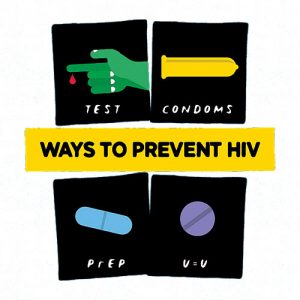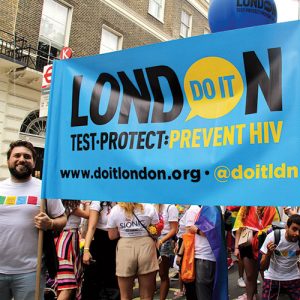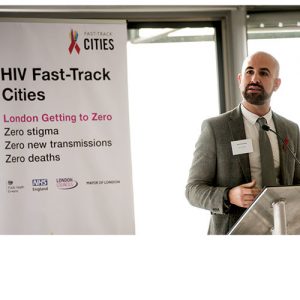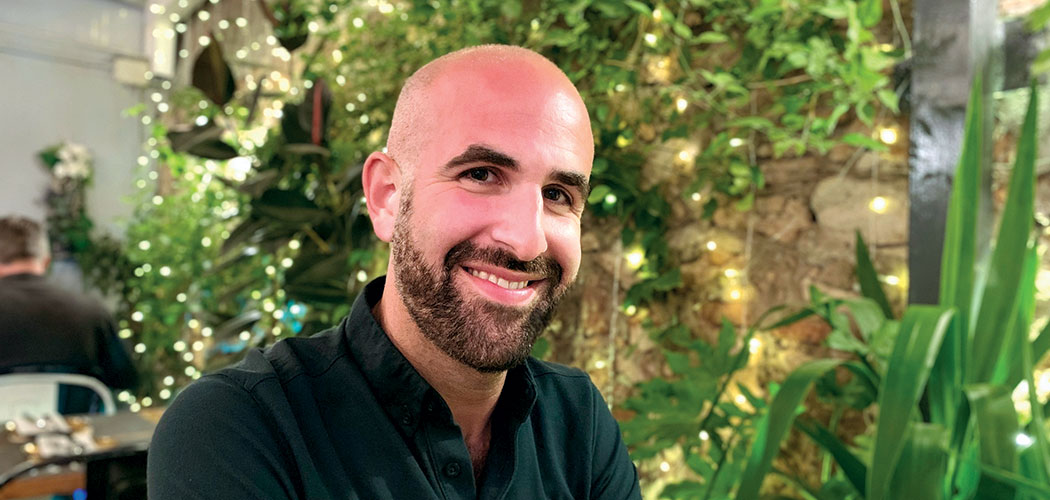Do It London has just launched its new summer campaign for gay men promoting the various ways we can help reduce HIV infections. The news is good as new HIV diagnoses amongst gay men have reduced by over 44% in the last few years. David Bridle talked to the London HIV Prevention Programme’s Lead Commissioner Paul Steinberg about this huge success.

New HIV infections have dropped by 44% in gay and bisexual men, why do you think this has happened?
It’s been a combination of factors. We’ve been promoting combination prevention and according to Public Health England (PHE) interestingly the reductions predate the availability of or at least wide access to PrEP. PHE has stated over the last couple of years that a very large increase in testing rates, particularly in men who have sex with men, from about 2014-15 onwards, has made a major contribution to that fall. What it means is more people being tested but also those same people being tested more frequently. So whereas we used to see people maybe get tested once every year or two, we’ve really seen the shift in the last years to testing two, three or even four times a year. That’s not to say PrEP hasn’t played a role. The other really important element is that because of all that increased testing, if somebody tests positive – unlike five or ten years ago – we’ve been giving people prompt treatment of antiretrovirals within days. We know that’s played a huge role in reducing both individual infection risk but also community viral load.
How many gay men in London have HIV and don’t know it?
We used to say there was about 10,000 to 15,000 people who had HIV but didn’t know it in London and now we’re saying that’s down to two thousand, of which about 1,000 are gay men. So really that test and treat policy of the public health authorities going back to the early part of this decade is starting to pay off. But also we know that since 2016 probably hundreds of gay men here in London were buying PrEP online from foreign pharmacies. Also the Proud trial in 2014-16 was giving some people PrEP and then from October 2017 we’ve had the Impact trial and very quickly the 7000 places allocated to London filled up with people using PrEP. And I should say, of course, people we know are still using condoms because we give out a million free condoms a year in London – and they’re still being taken.

What does Do It London do?
Do It London is effectively the brand of the London HIV Prevention Programme which was set up in 2014 by the political leaders of the London boroughs and by the directors of public health at the point where public health became the responsibility of local government. The programme consists of three main elements: Do it London is the big public facing campaigns, all the adverts, social media interactions on Facebook, Instagram and Twitter. That branding extends to the other elements, the free condom schemes; if you walk into any of the around 50 odd gay venues around Greater London, you’ll be able to pick up free condoms, often they’re in Do It London packs or they’re loose if they’re in a sauna or a sex club. And then the other element is the sexual health promotion outreach service which is in partnership with the Metro Centre, and they go out and they deliver outreach and rapid testing also in venues. So venues and the scene are a very important part of the London programme.
Have you found that the scene has responded better to you in the last few years?
We have actually. We had the good news before Christmas that the programme is being renewed again until 2022 and a big part of what we’re doing is engaging with our service users and that’s not just gay men on the outreach service, but it’s also the venues who host the outreach service and allow us to put our condoms in but also give a space to do rapid testing. We did a big survey of the venues in June and I would say overwhelmingly, in fact unanimously, they all said that they valued the service and saw the benefit of the service. If I remember back to when I first started this job in 2014 I don’t think that same relationship was there. I don’t think they understood the need for it. But also I’ve said for many years that we wanted to make public health and HIV prevention in particular, the responsibility of everybody across the the scene and I think that the venues have really stepped up to that. So without wanting to name specific venues, we certainly have had great partnerships with a number of bars and clubs in London. I think they know who they are and they support Do It London in terms of getting our message across both in terms of the campaign but also through the physical face-to-face outreach.

One of the issues I know you feel very strongly about is cuts to sexual health services because it’s all well and good to be promoting HIV testing but cuts in services make it more difficult for gay men to actually get tested?
Yes and it’s very challenging. The key point to make is that since 2015 when the public health cuts started, and they were set at the time by George Osborne for every year at least until 2020, we’ve really seen those cuts bite. What that’s meant for London is the largest per head cut in the budget compared to any other region in England. So that’s a 15% cut per person between 2015 and 2020. In that same time, we know that testing for HIV and screening for STIs has gone up over all by about 20%. I saw a figure the other day that said that gay men are now accessing screening services at an 83% higher rate than in 2013. So what we’ve seen is this increase in demand for HIV testing and sexual health services at the same time that the budgets have been shrinking. I think one of the interesting things is that London, before those cuts came in, was moving towards what was called the sexual health transformation or also known as the ‘e-service’. Effectively the shift to what’s now known as our partner Sexual Health London, which is the online sexual health testing service for people with no symptoms. That was set up in part because we needed to save money, but also because technology allows people to do that and people were telling us that they wanted to be able to test when the clinic was closed in the comfort of their own home.
As you said there’s still 1,000 gay men in London who have HIV but haven’t tested and that also ties into the issue of late testing. Do you have any understanding of why some gay men are still untested – and carrying the virus obviously?
And probably it’s causing damage to their own health and it’s posing an onward infection risk. We know that most HIV is transmitted from people who don’t even know they have it. I think it’s quite complicated. What we know from PHE is that late diagnosis is better in gay men – 25% in gay men rather than the average of 35%. Actually heterosexual, straight men are 50% late, so as a community we’re doing quite well, but a quarter of our community that test positive are still testing too late. A large proportion of new HIV diagnoses last year among gay men – and bear in mind it was a huge drop between 2015 and 2017 of 44% – are not UK born. They live here, they work here, they socialise here, they love here, they have sex here and they’ve chosen to make London their home, but a large proportion of them are from Eastern Europe and from South America. One of the things we think we need to do better is to try to reach those communities for whom maybe English isn’t their first language. I think one of the things we know is as the number of undiagnosed people get smaller, which is great, it gets harder to actually reach them because if somebody’s not tested 5 years ago, they’re still probably not going to test now. What we’re trying to do is actually make testing more routine in other places. Many of your readers will notice if they go to their GP or many A&Es around London are doing routine screening for HIV and they don’t even ask you for your permission. It’s called opt outs and we think that’s actually helping to drive down the rates of HIV.

The increasing rate of sexually transmitted infections amongst gay men is worrying. Gay men account for 75% of all syphilis diagnoses and half of all gonorrhoea diagnoses. Amongst gay men, syphilis cases have gone up 61% and gonorrhoea up 41%, compared to 5 years ago. Are we going to have a severe epidemic of STIs as we try and bring HIV down?
That’s a good question. I think we’re in the middle of an epidemic of some STIs, gonorrhoea and syphilis. I for one am not convinced that it’s all because of PrEP. I think that what we’ve seen is the increase in testing for HIV has been accompanied by a huge increase in screening for STIs. Also people being on the PrEP trial means they’re getting screened four times a year whereas may be it used to be once every one or two years. Of course that’s going to uncover infections; what’s important particularly with syphilis and gonorrhoea is that testing happens and that treatment happens as soon as possible to prevent onwards infection. I know that public health consultant colleagues of mine are absolutely petrified about drug resistant gonorrhoea, and they’re really concerned about syphilis, and I suppose my response to it is, being afraid and pointing the finger at individual things like PrEP is probably not very useful because behavior is changing, people are having more condomless sex, and so we need to rethink our sexual health promotion strategy for the 2020s.
Do you see Do It London getting more involved in other sexual health campaigns than just HIV?
When we are engaging with our service users and service partners like gay venues, but also when we’re talking to the public health commissioners in the London boroughs, they all wanted us to see through what we’re doing on HIV, but they were really keen that our outreach and testing and health promotion offer in the venues starts to address this broader ‘sexual health of gay men’ issue. So yes, watch this space. This is a particular problem for London because we have such a large population of gay men, but everywhere in the country with big cities are seeing a similar thing around STIs.
On a personal level, how are you feeling about where things are at right now?
I came into HIV prevention work in 2002 as a student volunteer and I look back and I think it’s been so great to be part of this story of success around reducing HIV. I think often we underplay the huge success that we’ve all witnessed in the last three or four years – because it is astounding. You and I go back so many years that we remember when it was just going up and up and up. So to bring HIV down and to have played a role in that, is incredibly satisfying. I increasingly over the years have valued the scene and our partners on the scene for this work because I don’t believe that you can achieve everything with the gay community through advertising. Our relationship with the scene venue owners and managers has been so crucial. It really concerns me that we are still seeing threats to our scene in London from developers or whatever it is, and the closure of clubs. I made it my mission to support venues as much as I can whether that’s The RVT a few years ago to XXL now, because I want to see a thriving scene – including a thriving sexual scene. Within that we play a role to ensure that all gay men in London have healthy but also fun lives because we’re not the sex police. We’re here to try to prevent HIV and STIs, but we’re not here to stop people from having fun.
For more on the Do It London campaign go to doitlondon.org














